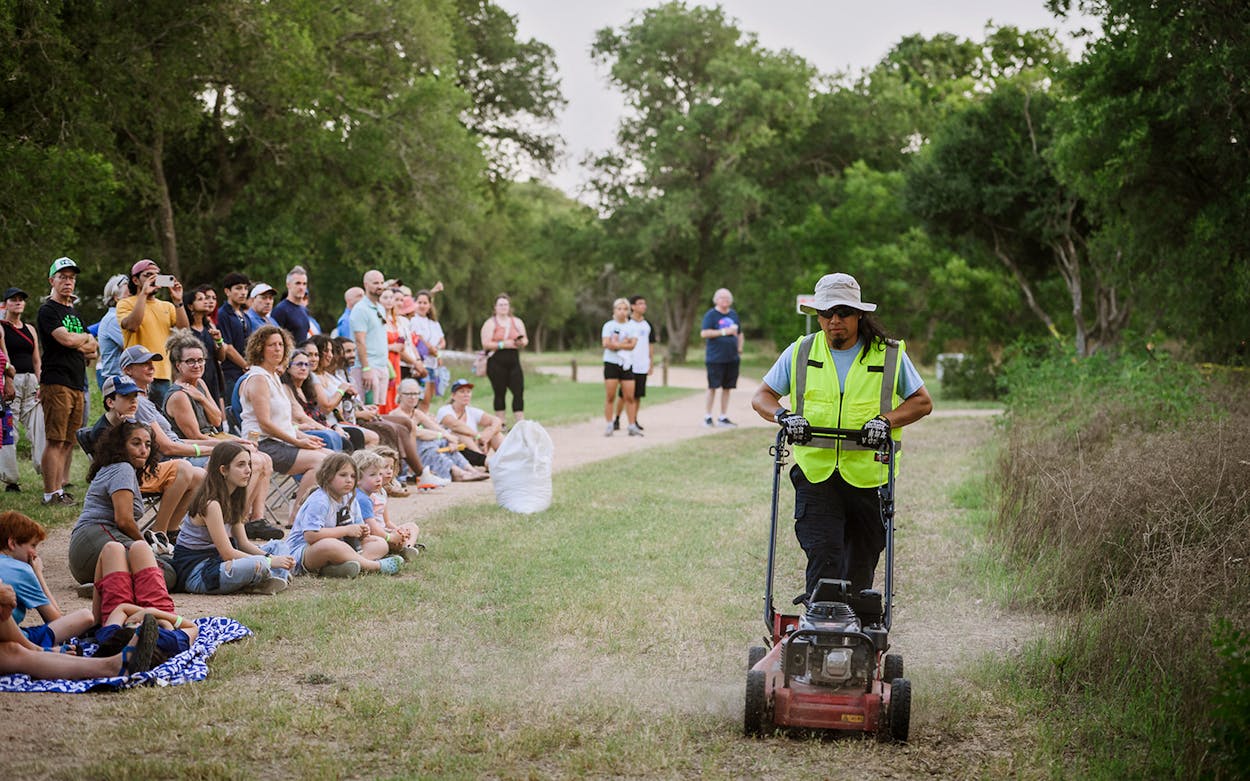On a blazing summer evening near the shores of Onion Creek, in Austin, a tour guide leads a group of theatergoers and me to the water’s edge, where meditative music plays from a large speaker. He asks us to sit on the bank, across from a cypress tree rising from its thirty feet of gnarled, exposed roots that stretch down into the green water. When the performance begins, three environmental scientists from the city’s Watershed Protection Department enter the creek and mock perform a routine inspection of the water, transforming their everyday motions into a work of art.
Turning day jobs into dance was the brainchild of Allison Orr. The choreography she creates as artistic director of the Austin-based Forklift Danceworks involves fifteen-ton trash trucks turning in unison or food-service employees pushing stainless steel carts to the beat of an original score. In her latest work, The Way of Water: Onion Creek, Orr and her team have performers wielding chain saws, pushing lawn mowers, and tossing out fistfuls of wildflower seeds.
Forklift has been pushing the boundaries of dance since Orr founded the company, in 2001. You probably won’t find a pom-pom shake in her shows, but you might see sanitation workers, utility employees, or a vegetation-management crew. The movements these workers do on the job are something to celebrate; as Orr sees it, prima ballerinas aren’t the only ones whose bodies deserve to command our attention and respect.
Before she got the idea to choreograph for scientists and truck drivers, Orr was named the best kicker on Austin High School’s Red Jackets drill team. “I loved the spectacle and grandeur of the team, but there were deeply problematic things about it,” she says, citing examples including weight limits and body-shaming from dance directors. “But that’s where I really got my training in form, space, and precision. My drill team moves live deeply in my body.”
Not everyone understands her approach. Orr was at a “fancy New York City dance conference” a few years ago, and someone asked her if it was limiting to work with nonprofessional dancers. “I was like, I can’t believe you said that publicly,” she says. “We’ve worked with [electrical] linemen who free-climb three hundred and fifty feet in the air. We do things on a grand scale. Working this way is why I get up in the morning.”
It’s hard to understand the full impact of a Forklift show from a quick description or a photo. There’s often a mix of trained dancers and workers, and each piece focuses on an issue facing a local community, such as gentrification, population growth, or climate change. There is no standard formula: one show may feature singing and digital projection, while another stars a local minor-league baseball team throwing balls in an impressively fluid choreographed sequence.

“The amazing thing about these performances is it will always be an immersive experience into whatever job Forklift is exploring,” says Megan Davidson, a dance major at the University of Texas at Austin who performs in the Onion Creek show. “I’ve been in the dance world for ten years and this was my first time hearing about something like this. It’s an eye-opening experience.”
On that hot, dry Saturday evening in June, I headed about ten miles south of downtown Austin to Onion Creek to see what a Forklift show was all about. The Way of Water series is a multiyear, global project. It premiered this summer in Austin with preview-type “laboratory performances” limited to a small audience; a larger show will happen at the same location in September. Between now and 2026, the project will head to El Paso, Miami, and Venice, Italy. The core artistic team will travel with Orr, but she’ll collaborate with frontline workers and dancers in each community she visits. Orr has created pieces in Venice before, choreographing gondoliers moving in sync along the famed canals. She says that choreographing trash trucks was a breeze compared with the gondola project.
“There aren’t plugs in the walls,” Orr says. “And there isn’t a lot of space for eight gondolas to turn around in the water.” As with any Forklift project, part of the draw is leaving the audience wondering how the heck the artists pulled it all off.
There are no gondoliers in sight at Onion Creek. About one hundred audience members fan themselves beneath the cypress trees. The air is abuzz with a summer symphony of cicadas, crickets, and locusts. You wouldn’t know it from a glance, but the parkland was once a neighborhood of more than five hundred homes. After several decades of catastrophic flooding that caused several fatalities, in 1998 the City of Austin partnered with the U.S. Army Corps of Engineers to move the families out of the floodplain. With The Way of Water: Onion Creek, Orr has a two-pronged mission: to celebrate the return of the area to its natural environment and honor the families who were displaced.
Before the show starts, the crew and performers gather in a circle, and everyone names something they’re excited about. There is a mix of professional and nonprofessional dancers in white T-shirts, black shorts and kneepads; vegetation-management workers wearing neon-yellow safety vests; and scientists from the Watershed Protection Department preparing to dance across picnic tables and balance jars of water on their heads as they plié. One woman says she’s looking forward to “magical moments.” Another says she hopes that “hearts and minds are moved.” One of the scientists declares that her hope is to “find more interesting bugs.”
The cast circle disperses and a few singers do vocal warm-ups with guest musical artist Vanessa Burden, who wears a sheer emerald-green-and-gold dress, a crown, a gold fanny pack, and sandals. She looks like a mystical forest sprite, circa 2023 in Austin. The singers follow Burden’s lead, blowing air out of their lips, drowning out the insects. It’s actually a pretty relaxing tune.
The laboratory performance consists of three acts, each in a different location. When the dance at the creek’s edge ends, I’m led with my fellow blue-wristband wearers to a grassy area, where members of the park’s vegetation-management crew trim branches (in keeping with park regulations) and throw out wildflower seeds. As they chop and clear, you hear recordings of the workers talking about their jobs and about the little things that remind them that this park was once a neighborhood where parents cooked dinner and kids caught the bus to school. One crew member says she loves seeing the wildflowers pop up, but what strikes her are the patches of purple irises that return year after year, reminding her that the land was someone’s home, and the seeds they planted just keep on sprouting blooms, long after the people have left.
By the time we’re led to the park pavilion for the final performance, it’s dark enough for candles to light the way. Guest choreographer José Ome Navarrete Mazatl holds up a light so we can see the final dance, performed by trained dancers such as Davidson and nonprofessionals. As a dance lover, I’ve seen classical ballet, modern, and a pretty impressive polka group, but the Forklift experience is something unique.
When I call Orr a few days after the show, she speaks passionately about opening discussions around drought, climate change, and flooding over the next few years as this series grows and expands. She hopes the project helps people understand that climate change is happening in their own backyards and that there are ways they can help—if not on a global scale, then in their own communities.
“With the impacts of heat and drought and flooding we’re seeing, I think I have job security,” Orr says. “Scientists are not storytellers, God love them. Scientists need us and we need scientists. I hope we as artists are able to be part of the solution.”
- More About:
- Austin






